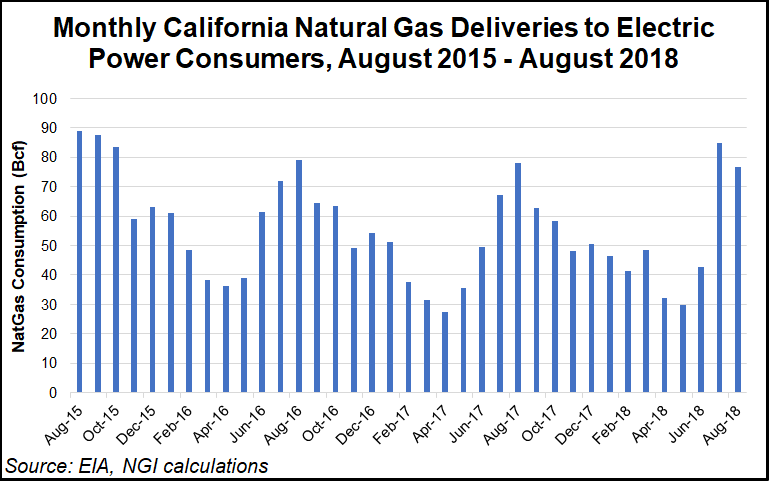Regulatory | Infrastructure | NGI All News Access | NGI The Weekly Gas Market Report
California OKs PG&E Plan to Replace Gas-Fired Power Plants with Battery Storage
California regulators have approved plans outlined late last year by Pacific Gas and Electric Co. (PG&E) to replace at least three Bay Area natural gas-fired peaking plants with battery storage and to add batteries at an existing gas-fired plant at Moss Landing, CA.

Three of the battery projects, with a capacity of 385 MW, will be owned and operated by third parties, and the fourth will be a 182.5 MW project that Tesla is to construct and PG&E would eventually own.
“Because the projects are all needed for reliability, their costs may be recovered for all ratepayers,” said Simon Baker, deputy director of the California Public Utilities Commission’s (CPUC) energy division. PG&E will be required to file annual reports to the CPUC on the ongoing programs.
Last December, the CPUC asked PG&E to determine if storage or other alternatives to fossil fuel could replace the Feather River, Yuba City and Metcalf Energy Center gas-fired peaking plants, all of which will give up reliability-must-run (RMR) contracts with the California Independent System Operator (CAISO).
The five-member CPUC embraced the PG&E projects on a 4-1 vote. But they said that costs would have to be watched closely and recognized that there will likely be some market power issues that arise from the transformation.
CPUC President Michael Picker supported the projects, but said that they were costly and complicated. “Rather than procure more generation from expensive gas peakers, PG&E has gone out and signed expensive contracts for battery storage that allows us to use our clean resources more effectively,” Picker said. “While it is expensive, it is still cheaper than the gas contracts.”

Commissioner Clifford Rechtschaffen was the lone dissenting vote. He liked the projects but thought the one utility-owned project by Tesla should have been the subject of a formal regulatory application process.
The projects are all lithium ion technology. The developers are Tesla, Dynegy (300 MW), Hummingbird Energy Storage LLC (75 MW), and mNOC (10 MW). The projects will yield an estimated total benefit of $233 million over 10 years, according to the CPUC.
Last year, Calpine Corp. told CAISO that it wanted to drop participating generator agreements for four peaking plants. In June, it began assessing whether to make the San Jose, CA-based Metcalf plant available for CAISO dispatch beginning this year. Calpine said all five plants were uneconomic to run at current prices.
Calpine requested that CAISO run studies on each plant to determine whether they were needed to ensure local reliability. CAISO determined Yuba City and Feather River were needed to meet local capacity needs and designated them as RMR. In late 2017, CAISO determined that the Metcalf plant was needed for local reliability, also designating it as RMR.
© 2024 Natural Gas Intelligence. All rights reserved.
ISSN © 1532-1231 | ISSN © 2577-9877 | ISSN © 1532-1266 |
